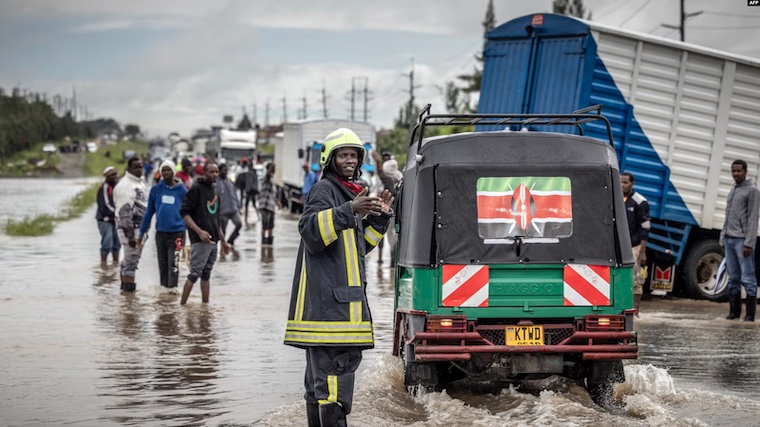The death toll from flood-related incidents in Kenya has crossed 200 since March, the Interior ministry said Friday, as a cyclone barreled towards the Tanzanian coast.

Torrential rains have lashed East Africa, triggering flooding and landslides that have destroyed crops, swallowed homes, and displaced hundreds of thousands of people. Some 210 people have died in Kenya “due to severe weather conditions,” the Interior ministry said in a statement, with 22 killed in the past 24 hours.
More than 165,000 people had been uprooted from their home, it added, with 90 others missing, raising fears that the toll could rise further.
Kenya and neighbouring Tanzania, where at least 155 people have been killed in flooding, are bracing for cyclone Hidaya, bringing heavy rain, wind and waves to their coasts. Tanzanian authorities warned Friday that Hidaya had “strengthened to reach the status of a full-fledged cyclone,” at 3:00 am local time when it was some 400 kilometres from the southeastern city of Mtwara.
“Cyclone Hidaya has continued to strengthen further, with wind speeds increasing to about 130 kilometres per hour,” they said in a weather bulletin.
Kenya’s Interior ministry forecast that the cyclone was likely to “bring strong winds and large ocean waves, with heavy rainfall” expected to hit the coast starting Sunday.
Race against the clock
Rescuers in boats and aircraft have raced against the clock in pouring rain to help people marooned by the floods in Kenya. In dramatic footage shared on Monday, the Kenya Red Cross rescued a man who said he was stranded by floodwaters and forced to shelter in a tree for five days in Garissa in the country’s east.
The country’s military also joined search and rescue efforts after President William Ruto deployed them to evacuate everyone living in flood-prone areas. Opposition politicians and lobby groups have accused Ruto’s government of being unprepared and slow to respond to the crisis despite weather warnings.
In the deadliest single incident in Kenya, dozens of villagers were killed when a makeshift dam burst on Monday near Mai Mahiu in the Rift Valley, about 60 kilometres north of Nairobi. The Interior ministry said 52 bodies had been recovered and 49 people were still missing after that disaster.
The ministry ordered that anyone living close to major rivers or near 178 “filled up or near filled up dams or water reservoirs” must vacate the area within 24 hours. The heavier-than-usual rains have also claimed at least 29 lives in Burundi, with 175 people injured, and tens of thousands displaced since September last year, the United Nations said.
The rains have been amplified by the El Nino weather pattern – a naturally occurring climate phenomenon typically associated with increased heat worldwide, leading to drought in some parts of the world and heavy downpours elsewhere.
Late last year, more than 300 people died in rains and floods in Kenya, Somalia and Ethiopia, just as the region was trying to recover from its worst drought in four decades. Cyclone season in the southwest of the Indian Ocean normally lasts from November to April and sees around a dozen storms each year.
